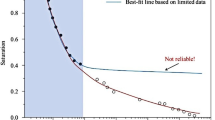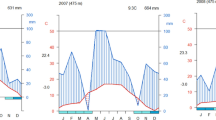Abstract
Direct measurements of soil–water characteristic curve (SWCC) are often costly and time consuming. As a result, a limited number of test data are usually obtained from a single SWCC test, based on which the estimated SWCC is unavoidably associated with uncertainties. It is, hence, prudent to deliberately plan the experimental scheme (i.e., specify the values of the control variable of measuring points) so as to improve the expected value of information of measurement data for reducing the uncertainty in estimated SWCC. This paper developed a Bayesian experimental design optimization (BEDO) approach for SWCC testing based on prior knowledge and information of testing apparatus. The proposed BEDO approach is divided into two stages to respectively identify initial measuring points for controlling the general trajectory of SWCC and determine additional measuring points for further reducing the uncertainty in SWCC. The experimental scheme with the maximum expected utility is identified as the optimal experimental scheme using Subset Simulation optimization in each stage. The proposed approach is illustrated using an experimental design example. Results show that it provides a rational tool to determine the optimal experiment scheme for SWCC testing in terms of the expected utility.




















Similar content being viewed by others
References
Au SK, Wang Y (2014) Engineering risk assessment with subset simulation. John Wiley & Sons, New Jersey
Bishop CM (2006) Pattern recognition and machine learning. Springer, Berlin
Burdine NT (1953) Relative permeability calculations from pore size distribution data. J Pet Technol 5(03):71–78. https://doi.org/10.2118/225-G
Cao ZJ, Wang Y, Li DQ (2016) Quantification of prior knowledge in geotechnical site characterization. Eng Geol 203:107–116. https://doi.org/10.1016/j.enggeo.2015.08.018
Chiu CF, Yan WM, Yuen KV (2012) Reliability analysis of soil-water characteristics curve and its application to slope stability analysis. Eng Geol 135:83–91. https://doi.org/10.1016/j.enggeo.2012.03.004
De Rooij GH, Kasteel RT, Papritz A, Flühler H (2004) Joint distributions of the unsaturated soil hydraulic parameters and their effect on other variates. Vadose Zone J 3:947–955. https://doi.org/10.2136/vzj2004.0947
Fredlund DG, Rahardjo H, Fredlund MD (2012) Unsaturated soil mechanics in engineering practice. John Wiley & Sons, New Jersey
Fredlund DG, Xing A (1994) Equations for the soil-water characteristic curve. Can Geotech J 31:521–532. https://doi.org/10.1139/t94-061
Gatabin C, Talandier J, Collin F, Charlier R, Dieudonné AC (2016) Competing effects of volume change and water uptake on the water retention behaviour of a compacted MX-80 bentonite/sand mixture. Appl Clay Sci 121:57–62. https://doi.org/10.1016/j.clay.2015.12.019
Gilbert RB, Habibi M (2015) Assessing the value of information to design site investigation and construction quality assurance programs Risk and Reliability in Geotechnical Engineering. CRC Press, Boca Raton, pp 521–562
Huan X, Marzouk YM (2013) Simulation-based optimal Bayesian experimental design for nonlinear systems. J Comput Phys 232:288–317. https://doi.org/10.1016/j.jcp.2012.08.013
Huang J, Zeng C, Kelly R (2019) Back analysis of settlement of Teven Road trial embankment using Bayesian updating. Georisk Assess Manag Risk Eng Syst Geohazards 13:320–325. https://doi.org/10.1080/17499518.2019.1641609
Juang CH, Zhang J, Shen M, Hu J (2019) Probabilistic methods for unified treatment of geotechnical and geological uncertainties in a geotechnical analysis. Eng Geol 249:148–161. https://doi.org/10.1016/j.enggeo.2018.12.010
Konakli K, Faber MH (2014) Value of Information Analysis in Structural Safety. https://doi.org/10.1061/9780784413609.161
Li DQ, Wang L, Cao ZJ, Qi XH (2019) Reliability analysis of unsaturated slope stability considering SWCC model selection and parameter uncertainties. Eng Geol 260:105207. https://doi.org/10.1016/j.enggeo.2019.105207
Li HS, Cao ZJ (2016) Matlab codes of Subset Simulation for reliability analysis and structural optimization. Struct Multidiscipl Optim 54:391–410. https://doi.org/10.1007/s00158-016-1414-5
Li HS, Ma YZ (2015) Discrete optimum design for truss structures by subset simulation algorithm. J Aerosp Eng 28(4):04014091. https://doi.org/10.1061/(ASCE)AS.1943-5525.0000411
Li HS, Au SK (2010) Design optimization using subset simulation algorithm. Struct Saf 32:384–392. https://doi.org/10.1016/j.strusafe.2010.03.001
Li HS (2011) Subset simulation for unconstrained global optimization. Appl Math Model 35:5108–5120. https://doi.org/10.1016/j.apm.2011.04.023
Li XY, Zhang LM, Jiang SH, Li DQ, Zhou CB (2016) Assessment of slope stability in the monitoring parameter space. J Geotech Geoenviron Eng 142:04016029. https://doi.org/10.1061/(ASCE)GT.1943-5606.0001490
Lu N, Likos WJ (2004) Unsaturated soil mechanics. Wiley, New Jersey
Mualem Y (1976) A new model for predicting the hydraulic conductivity of unsaturated porous media. Water Resour Res 12(3):513–522. https://doi.org/10.1029/WR012i003p00513
Nam S, Gutierrez M, Diplas P, Petrie J, Wayllace A, Lu N, Muñoz JJ (2009) Comparison of testing techniques and models for establishing the SWCC of riverbank soils. Eng Geol 110:1–10. https://doi.org/10.1016/j.enggeo.2009.09.003
Phoon KK, Santoso AM, Quek ST (2010) Probabilistic analysis of soil-water characteristic curves. J Geotechn Geoenviron Eng 136:445–455. https://doi.org/10.1061/(ASCE)GT.1943-5606.0000222
Prakash A, Hazra B, Sreedeep S (2020a) Probabilistic analysis of soil-water characteristic curve using limited data. Appl Math Model 89:752–770. https://doi.org/10.1016/j.apm.2020.08.023
Prakash A, Hazra B, Sekharan S (2020b) Probabilistic analysis of soil-water characteristic curve of bentonite: multivariate copula approach. Int J Geomech 20:04019150. https://doi.org/10.1061/(ASCE)GM.1943-5622.0001554
Santoso AM, Phoon KK, Quek ST (2011) Effects of soil spatial variability on rainfall-induced landslides. Comput Struct 89:893–900. https://doi.org/10.1016/j.compstruc.2011.02.016
Straub D (2014) Value of information analysis with structural reliability methods. Struct Saf 49:75–85. https://doi.org/10.1016/j.strusafe.2013.08.006
Schweckendiek T, Vrouwenvelder ACWM (2013) Reliability updating and decision analysis for head monitoring of levees. Georisk Assess Manag Risk Eng Syst Geohazards 7:110–121. https://doi.org/10.1080/17499518.2013.791034
Sillers WS, Fredlund DG (2001) Statistical assessment of soil-water characteristic curve models for geotechnical engineering. Can Geotech J 38:1297–1313. https://doi.org/10.1139/cgj-38-6-1297
Sivia D, Skilling J (2006) Data analysis: a Bayesian tutorial. OUP Oxford, Oxford
Van Genuchten MT (1980) A closed-form equation for predicting the hydraulic conductivity of unsaturated soils 1. Soil Sci Soc Am J 44:92–898. https://doi.org/10.2136/sssaj1980.03615995004400050002x
Wang JP, Xu Y (2015) Estimating the standard deviation of soil properties with limited samples through the Bayesian approach. Bull Eng Geology Environ 74:271–278. https://doi.org/10.1007/s10064-014-0609-5
Wang L, Cao ZJ, Li DQ, Phoon KK, Au SK (2018) Determination of site-specific soil-water characteristic curve from a limited number of test data–a Bayesian perspective. Geosci Front 9:1665–1677. https://doi.org/10.1016/j.gsf.2017.10.014
Wang L, Wu C, Gu X, Liu H, Zhang W (2020) Probabilistic stability analysis of earth dam slope under transient seepage using multivariate adaptive regression splines. Bull Eng Geol Environ 79:2763–2775. https://doi.org/10.1007/s10064-020-01730-0
Yang HQ, Zhang L, Xue J, Zhang J, Li X (2019) Unsaturated soil slope characterization with Karhunen-Loève and polynomial chaos via Bayesian approach. Eng Comput 35(1):337–350. https://doi.org/10.1007/s00366-018-0610-x
Yuan J, Papaioannou I, Straub D (2019) Probabilistic failure analysis of infinite slopes under random rainfall processes and spatially variable soil. Georisk Assess Manag Risk Eng Syst Geohazards 13:20–33. https://doi.org/10.1080/17499518.2018.1489059
Yoshida I, Tasaki Y, Otake Y, Wu S (2018) Optimal sampling placement in a Gaussian random field based on value of information. ASCE ASME J Risk Uncertain Eng Syst A Civ Eng 4:04018018. https://doi.org/10.1061/AJRUA6.0000970
Zetterlund MS, Norberg T, Ericsson LO, Norrman J, Rosén L (2015) Value of information analysis in rock engineering: a case study of a tunnel project in Äspö Hard Rock Laboratory. Georisk Assess Manag Risk Eng Syst Geohazards 9:9–24. https://doi.org/10.1080/17499518.2014.1001401
Zhai Q, Rahardjo H (2012) Determination of soil-water characteristic curve variables. Comput Geotech 42:37–43. https://doi.org/10.1016/j.compgeo.2011.11.010
Zhai Q, Rahardjo H, Satyanaga A (2017) Effects of residual suction and residual water content on the estimation of permeability function. Geoderma 303:165–177. https://doi.org/10.1016/j.geoderma.2017.05.019
Zhang JJ, Zeng LZ, Chen C, Chen DJ, Wu LS (2015) Efficient Bayesian experimental design for contaminant source identification. Water Resour Res 51:576–598. https://doi.org/10.1002/2014WR015740
Zhang WT, Yu HM (2009) Applications of orthogonal experiment design to sensitivity analysis of bank landslide. Saf Environ Eng 16:13–16
Zhao TY, Wang Y (2019) Determination of efficient sampling locations in geotechnical site characterization using information entropy and Bayesian compressive sampling. Can Geotech J 56:1622–1637. https://doi.org/10.1139/cgj-2018-0286
Zhou WH, Yuen KV, Tan F (2014) Estimation of soil-water characteristic curve and relative permeability for granular soils with different initial dry densities. Eng Geol 179:1–9. https://doi.org/10.1016/j.enggeo.2014.06.013
Zhu H, Zhang L (2019) Root-soil-water hydrological interaction and its impact on slope stability. Georisk Assess Manag Risk Eng Syst Geohazards 13:349–359. https://doi.org/10.1080/17499518.2019.1616098
Zhu ZY, Gong DC (2014) Determination of the experimental conditions of the transglutaminase-mediated restoration of thermal aged silk by orthogonal experiment. J Cult Herit 15:18–25. https://doi.org/10.1016/j.culher.2012.12.002
Funding
This work was supported by the National Natural Science Foundation of China (Project Nos. 51879205, 51779189) and the Fundamental Research Funds for the Central Universities (Project No. 2042020kf0193). The financial support is gratefully acknowledged.
Author information
Authors and Affiliations
Corresponding author
Appendix 1: Derivation of the ψ i, ψ b, ψ r corresponding to VGM
Appendix 1: Derivation of the ψ i, ψ b, ψ r corresponding to VGM
The VGM is expressed as
At the inflection point, the \({\psi }_{i}\) satisfies (Zhai et al. 2017)
where \({\left.\frac{d{S}_{e}\left(\psi \right)}{d\psi }\right|}_{\psi ={\psi }_{i}}\) and \({\left.\frac{{d}^{2}{S}_{e}\left(\psi \right)}{d{\psi }^{2}}\right|}_{\psi ={\psi }_{i}}\) are respectively the first and second derivatives of the VGM evaluated at \({\psi }_{i}\), and they are given by
Substituting Eqs. (24) and (25) into Eq. (23) gives
The Eq. (26) can be further simplified as
Using Eq. (27), the \({\psi }_{i}\) can be calculated for a given set of VGM parameters, i.e., \({\alpha }_{vm}\) and \({n}_{vm}\). Moreover, the k1 (see Fig. 4) can be defined as follows (Zhai and Rahardjo 2012):
Therefore, the air-entry value \({\psi }_{b}\) is given by
In addition, the k1 and k2 (see Fig. 4) can be written as (Zhai and Rahardjo 2012)
Substituting Eq. (30) into Eq. (31) gives
Using Eq. (32), the residual suction \({\psi }_{r}\) is written as
Equations (27), (29), and (33) allow calculating the \({\psi }_{i}\), \({\psi }_{b}\), and \({\psi }_{r}\) for a given set of \({\alpha }_{vm}\) and \({n}_{vm}\), respectively.
Rights and permissions
About this article
Cite this article
Ding, SL., Li, DQ., Cao, ZJ. et al. Two-stage Bayesian experimental design optimization for measuring soil–water characteristic curve. Bull Eng Geol Environ 81, 142 (2022). https://doi.org/10.1007/s10064-022-02598-y
Received:
Accepted:
Published:
DOI: https://doi.org/10.1007/s10064-022-02598-y




